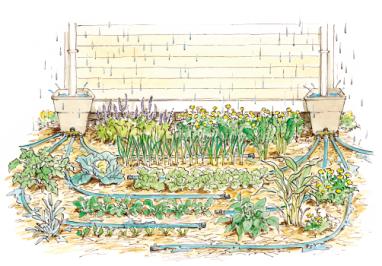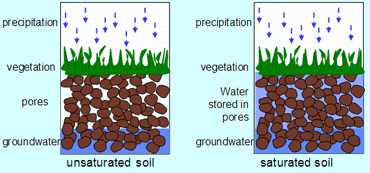
Storing water in soil
 Storing water in garden soil
sounds too good to be true. Is it?
Storing water in garden soil
sounds too good to be true. Is it?
The idea is that you can
channel excess water (such as the output of your gutters or the
overflow from your rain barrel) into the garden. This
Mother Earth News article provides an example of a very
simple-to-implement system (shown to the right) and this
information on Steve Solomon's website provides more technical
details on the soil side. You can recharge the soil during winter
rains, then your plants will be subirrigated during summer droughts.
But does soil water
storage work? I've run across lots of people mentioning the
concept, but no one who shows a multi-year system in action. Here
are my reservations:
- Won't filling up the soil during the winter flush water-soluble
micronutrients too deep for roots to reach them? (I
can taste the micronutrient deficiency in certain crops after extended
bouts of heavy rain already.)
- Doesn't my soil already get saturated during the winter? (I know it does in certain areas.)
- Won't saturated winter soil kill perennials?
- Doesn't the water slowly drip down to the groundwater layer and
then trickle out into nearby creeks and springs?
I decided to crunch some
numbers and see if my qualms had any basis in reality. Solomon's
information suggests that two to three inches of rainfall can be stored
in the top foot of your soil (with the exact amount depending on your
soil type --- clay holds more, sand holds less). Since some
plants can access moisture ten feet deep, we'll work with a value of 25
inches of plant-available water stored in the soil, which equates to
15.6 gallons of water per square foot of surface area.
 But here's the trouble: we
receive an average of 49 inches of rain per year, which means normal
precipitation would fill the soil bank up twice without adding any
extra water from our gutters. Yes, there's a lot of transpiration
and evaporation happening during the growing season, but I'm pretty
sure that there's not much (if any) room left for water in the soil at
the end of a normal winter in our area.
But here's the trouble: we
receive an average of 49 inches of rain per year, which means normal
precipitation would fill the soil bank up twice without adding any
extra water from our gutters. Yes, there's a lot of transpiration
and evaporation happening during the growing season, but I'm pretty
sure that there's not much (if any) room left for water in the soil at
the end of a normal winter in our area.
In drier parts of the
world, filling up your garden soil bank by diverting excess flow from
your roof probably makes more sense. But I think we'd need to get
creative if we wanted to put any more water into our soil during the
winter. Perhaps filling the aisles in our terraced back garden
with wood chips would do the trick (but I never have enough wood chips
to "waste" them on a nonessential use like that).
Back to the drawing
board....
Want more in-depth information? Browse through our books.
Or explore more posts by date or by subject.
About us: Anna Hess and Mark Hamilton spent over a decade living self-sufficiently in the mountains of Virginia before moving north to start over from scratch in the foothills of Ohio. They've experimented with permaculture, no-till gardening, trailersteading, home-based microbusinesses and much more, writing about their adventures in both blogs and books.
Want to be notified when new comments are posted on this page? Click on the RSS button after you add a comment to subscribe to the comment feed, or simply check the box beside "email replies to me" while writing your comment.

The standard way is to take a soil sample, weigh it, dry it and weigh it again. The difference in weight is the amount of water (and in theory other volatiles, but I don't think soils contains much else).
Drying can be done by putting the soil in an oven at >100°C until the weight doesn't decrease anymore.
Roland and De --- I think you're right that some scientific measurements are probably in order. Roland's method is the tried and true way, but I think there might be some simpler methods that would still give us semi-solid data.
They make moisture probes that you can stick a certain distance into the earth and see how saturated the soil is, but the little cheap one I have doesn't go very deep and doesn't seem very accurate. Another method would be to simply dig a hole and do a squeeze test to see how damp the soil is.
My tried and true method of telling that the ground is saturated is to see whether the water stays puddled on the surface a day after heavy rains.
It sounds to me like you don't really need to store any more water in your soil, but rather need to find a way to drain the top foot or so- at least around your trailer. If you can make a pond that would be ideal.
A few siphon linked IBCs should provide you with irrigation water if you suffer a dry spell. When they drop to a certain level, you can reconnect them to the downspout. When they are full, the spouts can drain far from the house.
Eric --- I'm like Tisha --- I really, really want to believe that soil water storage is useful. Unfortunately, the realist in me agrees with you --- I think that in our climate, we'd probably be better off just shunting the water off out of the way (or making a pond if we decided to get fancy.)
Tisha --- It sounds like your climate has significant dry periods, which is probably what it takes to make soil water storage worth its salt. We get so much water that I generally don't water perennials at all (although I keep meaning to hook up a system I can use during droughts).